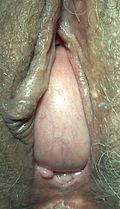| Cystocele | |
|---|---|
| Other names | Prolapsed bladder, dropped bladder,[1] anterior vaginal wall collapse[2] |
 | |
| A cystocele protruding through the vagina in a 73-year-old woman. | |
| Pronunciation | |
| Specialty | Urology, gynecology[3] |
| Symptoms | Trouble starting urination, incomplete urination, urinary incontinence, frequent urination[1] |
| Complications | Urinary retention[1] |
| Types | Grade 1, 2, 3[1] |
| Risk factors | Childbirth, constipation, chronic cough, heavy lifting, being overweight[1] |
| Diagnostic method | Based on symptoms and examination[1] |
| Differential diagnosis | Bartholin cyst, nabothian cyst, urethral diverticulum[4] |
| Treatment | Lifestyle changes, pelvic muscle exercises, vaginal pessary, surgery[1] |
| Frequency | ~33% of women > 50 years old[5] |
The cystocele, also known as a prolapsed bladder, is a medical condition in which a woman's bladder bulges into her vagina.[1][5] Some may have no symptoms.[6] Others may have trouble starting urination, urinary incontinence, or frequent urination.[1] Complications may include recurrent urinary tract infections and urinary retention.[1][7] Cystocele and a prolapsed urethra often occur together and is called a cystourethrocele.[8] Cystocele can negatively affect quality of life.[9][10]
Causes include childbirth, constipation, chronic cough, heavy lifting, hysterectomy, genetics, and being overweight.[1][2][6] The underlying mechanism involves weakening of muscles and connective tissue between the bladder and vagina.[1] Diagnosis is often based on symptoms and examination.[1]
If the cystocele causes few symptoms, avoiding heavy lifting or straining may be all that is recommended.[1] In those with more significant symptoms a vaginal pessary, pelvic muscle exercises, or surgery may be recommended.[1] The type of surgery typically done is known as a colporrhaphy.[11] The condition becomes more common with age.[1] About a third of women over the age of 50 are affected to some degree.[5]
- ^ a b c d e f g h i j k l m n o p "Cystocele (Prolapsed Bladder)". National Institute of Diabetes and Digestive and Kidney Diseases. March 2014. Archived from the original on 4 October 2017. Retrieved 25 October 2017.
- ^ a b Baggish, Michael S.; Karram, Mickey M. (2016). Atlas of pelvic anatomy and gynecologic surgery (4th ed.). Philadelphia, PA: Elsevier. pp. 599–646. ISBN 9780323225526. OCLC 929893382.
- ^ Liedl, Bernhard; Inoue, Hiromi; Sekiguchi, Yuki; Gold, Darren; Wagenlehner, Florian; Haverfield, Max; Petros, Peter (February 2017). "Update of the Integral Theory and System for Management of Pelvic Floor Dysfunction in Females". European Urology Supplements. 17 (3): 100–108. doi:10.1016/j.eursup.2017.01.001.
- ^ Federle, Michael P.; Tublin, Mitchell E.; Raman, Siva P. (2016). ExpertDDx: Abdomen and Pelvis E-Book. Elsevier Health Sciences. p. 626. ISBN 9780323443128. Archived from the original on 2017-10-25.
- ^ a b c Firoozi, Farzeen (2014). Female Pelvic Surgery. Springer. p. 73. ISBN 9781493915040. Archived from the original on 2017-10-25.
- ^ a b Williams, J. Whitridge (2012). Hoffman, Barbara L. (ed.). Williams gynecology (2nd ed.). New York: McGraw-Hill Medical. pp. 647–653. ISBN 9780071716727. OCLC 779244257.
- ^ Hamid, Rizwan; Losco, Giovanni (2014-09-01). "Pelvic Organ Prolapse-Associated Cystitis". Current Bladder Dysfunction Reports. 9 (3): 175–180. doi:10.1007/s11884-014-0249-4. ISSN 1931-7212. PMC 4137160. PMID 25170365.
- ^ "Cystoceles, Urethroceles, Enteroceles, and Rectoceles – Gynecology and Obstetrics – Merck Manuals Professional Edition". Merck Manuals Professional Edition. February 2017. Retrieved 2017-12-18.
- ^ "Cystocele (Fallen Bladder)". www.clevelandclinic.org. Archived from the original on 2017-12-29. Retrieved 2017-12-28.
- ^ Deng, Donna Y.; Rutman, Matthew; Rodriguez, Larissa; Raz, Shlomo (2005-09-01). "Correction of cystocele". BJU International. 96 (4): 691–709. doi:10.1111/j.1464-410x.2005.05760.x. ISSN 1464-410X. PMID 16104940. S2CID 32430707.
- ^ Halpern-Elenskaia, Ksenia; Umek, Wolfgang; Bodner-Adler, Barbara; Hanzal, Engelbert (2017-12-06). "Anterior colporrhaphy: a standard operation? Systematic review of the technical aspects of a common procedure in randomized controlled trials". International Urogynecology Journal. 29 (6): 781–788. doi:10.1007/s00192-017-3510-5. ISSN 0937-3462. PMC 5948274. PMID 29214325.